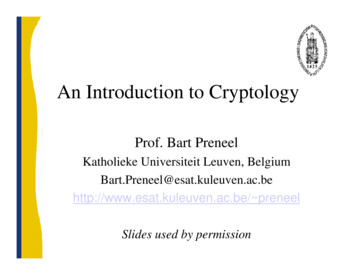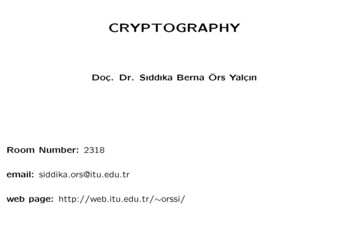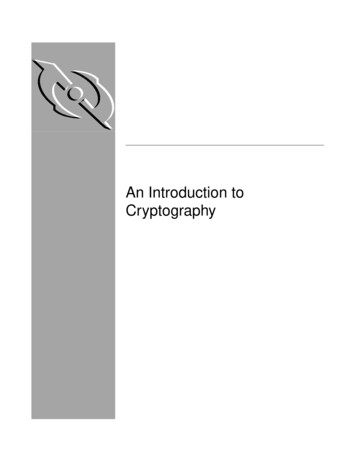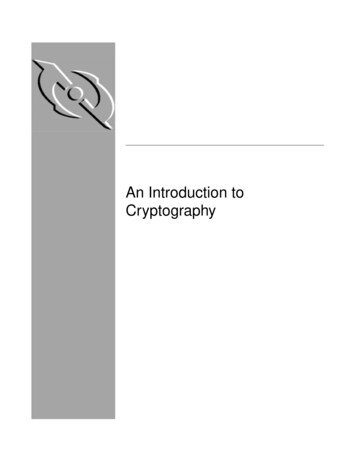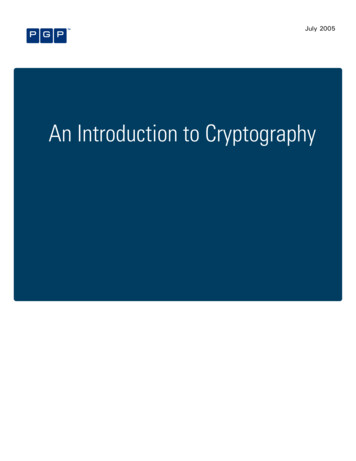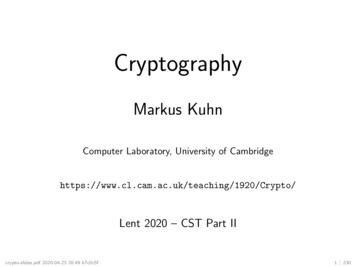
Transcription
CryptographyMarkus KuhnComputer Laboratory, University of ypto/Lent 2020 – CST Part IIcrypto-slides.pdf 2020-04-23 20:49 b7c0c5f1 / 230
What is this course about?AimsThis course provides an overview of basic modern cryptographictechniques and covers essential concepts that users of cryptographicstandards need to understand to achieve their intended security goals.ObjectivesBy the end of the course you shouldI be familiar with commonly used standardized cryptographic buildingblocks;I be able to match application requirements with concrete securitydefinitions and identify their absence in naive schemes;I understand various adversarial capabilities and basic attackalgorithms and how they affect key sizes;I understand and compare the finite groups most commonly used withdiscrete-logarithm schemes;I understand the basic number theory underlying the most commonpublic-key schemes, and some efficient implementation techniques.2 / 230
1Historic ciphers2Perfect secrecy3Semantic security4Block ciphers5Modes of operation6Message authenticity7Authenticated encryption8Secure hash functions9Secure hash applications10Key distribution problem11Number theory and group theory12Discrete logarithm problem13RSA trapdoor permutation14Digital signatures3 / 230
Related textbooksMain reference:I Jonathan Katz, Yehuda Lindell:Introduction to Modern Cryptography2nd ed., Chapman & Hall/CRC, 2014Further reading:I Christof Paar, Jan Pelzl:Understanding CryptographySpringer, 04100-6/http://www.crypto-textbook.com/I Douglas Stinson:Cryptography – Theory and Practice3rd ed., CRC Press, 2005I Menezes, van Oorschot, Vanstone:Handbook of Applied CryptographyCRC Press, 1996http://www.cacr.math.uwaterloo.ca/hac/The course notes and some of the exercises also contain URLs with moredetailed information.4 / 230
Common information security targetsMost information-security concerns fall into three broad categories:Confidentiality ensuring that information is accessible only to thoseauthorised to have accessIntegrity safeguarding the accuracy and completeness ofinformation and processing methodsAvailability ensuring that authorised users have access toinformation and associated assets when requiredBasic threat scenarios:Eavesdropper:(passive)Middle-person e security:AlicediskMallory5 / 230
Encryption schemesEncryption schemes are algorithm triples (Gen, Enc, Dec) aimed atfacilitating message confidentiality:Private-key (symmetric) encryption schemeI K GenI C EncK (M )I DecK (C) Mprivate-key generationencryption of plain-text message Mdecryption of cipher-text message CPublic-key (asymmetric) encryption schemeI (PK , SK ) GenI C EncPK (M )I DecSK (C) Mpublic/secret key-pair generationencryption using public keydecryption using secret keyProbabilistic algorithms: Gen and (often also) Enc access a random-bitgenerator that can toss coins (uniformly distributed, independent).Notation: assigns the output of a probabilistic algorithm, : that of a deterministic algorithm.6 / 230
Message integrity schemesOther cryptographic algorithm triples instead aim at authenticating theintegrity and origin of a message:Message authentication code (MAC)I K GenI T : MacK (M )private-key generationmessage tag generation?I M 0 6 M MacK (M 0 ) 6 TMAC verification:recalculate and compare tagDigital signatureI PK , SK GenI S SignSK (M )I VrfyPK (M, S) 1,public/secret key-pair generationsignature generation using secret keysignature verification using public key?M 0 6 M VrfyPK (M 0 , S) 07 / 230
Key exchangeKey-agreement protocolI (PK A , SK A ) Genpublic/secret key-pair generation by AliceI (PK B , SK B ) Gen public/secret key-pair generation by BobI K : DH(SK A , PK B ) key derivation from exchanged public keys DH(PK A , SK B )Diffie–Hellman protocol:Alice and Bob standardize suitably chosen very large public numbers g, p and q.Alice picks a random number 0 x q and Bob a secret number 0 y q astheir respective secret keys. They then exchange the corresponding public keys:A B:PK A g x mod pB A:PK B g y mod pAlice and Bob each now can calculateK (g y mod p)x mod p (g x mod p)y mod pand use that as a shared private key. With suitably chosen parameters, outsideobservers will not be able to infer x, y, or K.Why might one also want to sign or otherwise authenticate PK A and/or PK B ?8 / 230
Key typesI Private keys symmetric keysI Public/secret key pairs asymmetric keysWarning: this “private” vs “secret” key terminology is not universal in the literatureI Ephemeral keys / session keys are only used briefly and oftengenerated fresh for each communication session.They can be used to gain privacy (observers cannot identify users from public keysexchanged in clear) and forward secrecy (if a communication system gets compromised infuture, this will not compromise past communication).I Static keys remain unchanged over a longer period of time (typicallymonths or years) and are usually intended to identify users.Static public keys are usually sent as part of a signed “certificate” SignSK (A, PK A ),Cwhere a “trusted third party” or “certification authority” C certifies that PK A is the publickey associated with user A.I Master keys are used to generate other derived keys.I By purpose: encryption, message-integrity, authentication, signing,key-exchange, certification, revokation, attestation, etc. keys9 / 230
When is a cryptographic scheme “secure”?For an encryption scheme, if no adversary can . . .I . . . find out the secret/private key?I . . . find the plaintext message M ?I . . . determine any character/bit of M ?I . . . determine any information about M from C?I . . . compute any function of the plaintext M from ciphertext C? “semantic security”For an integrity scheme, should we demand that no adversary can . . .I . . . find out the secret/private key?I . . . create a new message M 0 and matching tag/signature?I . . . create a new M 0 that verifies with a given tag/signature?I . . . modify or recombine a message tag so they still verify?I . . . create two messages with the same signature?10 / 230
What capabilities may the adversary have?I access to some ciphertext CI access to some plaintext/ciphertext pairs (M, C) withC EncK (M )?I ability to trick the user of EncK into encrypting some plaintext ofthe adversary’s choice and return the result?(“oracle access” to Enc)I ability to trick the user of DecK into decrypting some ciphertext ofthe adversary’s choice and return the result?(“oracle access” to Dec)?I ability to modify or replace C en route?(not limited to eavesdropping)I how many applications of EncK or DecK can be observed?I unlimited / polynomial / realistic ( 280 steps) computation time?I knowledge of all algorithms usedWanted: Clear definitions of what security of an encryption schememeans, to guide both designers and users of schemes, and allow proofs.11 / 230
Kerckhoffs’ principles (1883)Requirements for a good traditional military encryption system:1The system must be substantially, if not mathematically,undecipherable;2The system must not require secrecy and can be stolen by theenemy without causing trouble;3It must be easy to communicate and remember the keys withoutrequiring written notes, it must also be easy to change or modify thekeys with different participants;4The system ought to be compatible with telegraph communication;5The system must be portable, and its use must not require morethan one person;6Finally, regarding the circumstances in which such system is applied,it must be easy to use and must neither require stress of mind northe knowledge of a long series of rules.Auguste Kerckhoffs: La cryptographie militaire, Journal des sciences militaires, 1883.http://petitcolas.net/fabien/kerckhoffs/12 / 230
Kerckhoffs’ principles (1883)Requirements for a good traditional military encryption system:1The system must be substantially, if not mathematically,undecipherable;2The system must not require secrecy and can be stolen by theenemy without causing trouble;3It must be easy to communicate and remember the keys withoutrequiring written notes, it must also be easy to change or modify thekeys with different participants;4The system ought to be compatible with telegraph communication;5The system must be portable, and its use must not require morethan one person;6Finally, regarding the circumstances in which such system is applied,it must be easy to use and must neither require stress of mind northe knowledge of a long series of rules.Auguste Kerckhoffs: La cryptographie militaire, Journal des sciences militaires, 1883.http://petitcolas.net/fabien/kerckhoffs/12 / 230
Kerckhoffs’ principle todayRequirement for a modern encryption system:1It was evaluated assuming that the enemy knows the system.2Its security relies entirely on the key being secret.13 / 230
Kerckhoffs’ principle todayRequirement for a modern encryption system:1It was evaluated assuming that the enemy knows the system.2Its security relies entirely on the key being secret.Note:I The design and implementation of a secure communication system isa major investment and is not easily and quickly repeated.I Relying on the enemy not knowing the encryption system isgenerally frowned upon as “security by obscurity”.I The most trusted cryptographic algorithms have been published,standardized, and withstood years of cryptanalysis.I A cryptographic key should be just a random choice that can beeasily replaced, by rerunning a key-generation algorithm.I Keys can and will be lost: cryptographic systems should providesupport for easy rekeying, redistribution of keys, and quickrevocation of compromised keys.13 / 230
A note about message lengthWe explicitly do not worry in the following about the adversary beingable to infer something about the length m of the plaintext message Mby looking at the length n of the ciphertext C.Therefore, we will consider here in security definitions for encryptionschemes only messages of fixed length m.Variable-length messages could be extended to a fixed length, bypadding, but this can be expensive. It will depend on the specificapplication whether the benefits of fixed-length padding outweigh theadded transmission cost.Nevertheless, in practice, ciphertext length must always be considered asa potential information leak. Examples:I Encrypted-file lengths often permit unambiguous reconstruction ofwhat pages a HTTPS user accessed on a public web site.G. Danezis: Traffic analysis of the HTTP protocol over s/TLSanon.pdfI Data compression can be abused to extract information from anencrypted message if an adversary can control part of that message.J. Kelsey: Compression and information leakage of 2/FSE/3091/3091.pdfAlso: CVE-2012-4929/CRIME14 / 230
Demo: leaking plaintext through compressed data length cat compression-leak#!/bin/bashPLAINTEXT cafe KEY "N-32m5qEj/emdVr.69w1fX"ENC "openssl enc -aes-128-ctr -pass pass: KEY"for t in f} ; doecho -n " t "echo t PLAINTEXT gzip -c ENC wc -cdone sort -nk2 ./compression-leak15 / 230
Demo: leaking plaintext through compressed data length cat compression-leak#!/bin/bashPLAINTEXT cafe KEY "N-32m5qEj/emdVr.69w1fX"ENC "openssl enc -aes-128-ctr -pass pass: KEY"for t in f} ; doecho -n " t "echo t PLAINTEXT gzip -c ENC wc -cdone sort -nk2 ./compression-leakaafe 44acaf 44bafe 44bcaf 44cafe 44 ccaf 44dafe 44dcaf 44eafe 44ecaf 44fafe 44fcaf 44aaaa 46aaab 46[. . . remaining 1282 lines not shown . . . ]15 / 230
1Historic ciphers2Perfect secrecy3Semantic security4Block ciphers5Modes of operation6Message authenticity7Authenticated encryption8Secure hash functions9Secure hash applications10Key distribution problem11Number theory and group theory12Discrete logarithm problem13RSA trapdoor permutation14Digital signatures16 / 230
Historic examples of simple ciphersShift Cipher: Treat letters {A, . . . , Z} like integers {0, . . . , 25} Z26 .Choose key K Z26 , encrypt each letter individually by addition modulo26, decrypt by subtraction modulo 26.Example with K 25 1 (mod 26): IBM HAL.K 3 known as Caesar Cipher, K 13 as rot13.The tiny key-space size 26 makes brute-force key search trivial.Transposition Cipher: K is permutation of letter positions.Key space is n!, where n is the permutation block length.A T T A C K A T D A W NT A N W T C A K D A T AAATTUBETDTAANCWORKNTEOFBSkytaleSubstitution Cipher (monoalphabetic): Key is permutationK : Z26 Z26 . Encrypt plaintext M m1 m2 . . . mn with ci K(mi )to get ciphertext C c1 c2 . . . cn , decrypt with mi K 1 (ci ).Key space size 26! 4 1026 makes brute-force search infeasible.17 / 230
Statistical properties of plain text%English letter frequency131211109876543210ETAHINDBCOR SLMF GKJUPQWVYXZThe most common letters in English:E, T, A, O, I, N, S, H, R, D, L, U, . . .The most common digrams in English:TH, HE, IN, ER, AN, RE, ED, ON, ES, ST, EN, AT, TO, . . .The most common trigrams in English:THE, ING, AND, HER, ERE, ENT, THA, NTH, WAS, ETH, . . .English text is highly redundant: very roughly 1 bit/letter entropy.Monoalphabetic substitution ciphers allow simple ciphertext-only attacks based ondigram or trigram statistics (for messages of at least few hundred characters).18 / 230
Statistical properties of plain text%English letter frequency131211109876543210ETAOI NS H RD LU WMF C G Y PB KVJ X Q ZThe most common letters in English:E, T, A, O, I, N, S, H, R, D, L, U, . . .The most common digrams in English:TH, HE, IN, ER, AN, RE, ED, ON, ES, ST, EN, AT, TO, . . .The most common trigrams in English:THE, ING, AND, HER, ERE, ENT, THA, NTH, WAS, ETH, . . .English text is highly redundant: very roughly 1 bit/letter entropy.Monoalphabetic substitution ciphers allow simple ciphertext-only attacks based ondigram or trigram statistics (for messages of at least few hundred characters).18 / 230
Vigenère cipherInputs:I Key word K k1 k2 . . . klI Plain text M m1 m2 . . . mnEncrypt into ciphertext:ci (mi k[(i 1) mod l] 1 ) mod 26Example: K SECRETSASETXCTVRARECGTKDSASETXCDF.The modular addition can be replaced with XOR:ci mi k[(i 1) mod l] 1mi , ki , ci {0, WXZABCDEFGHIJKLMNOPQRSTUVWXYVigenère is an example of a polyalphabetic cipher.19 / 230
Attacking the Vigenère cipherFirst determine the key length l. For each candidate keylength l:I Treat each l-th ciphertext character as part of a separate messageM1 , M2 , . . . , Ml encrypted with just a (monoalphabetic) shift cipher, resulting inseparate ciphertexts C1 , C2 , . . . , Cl .I Consider the l letter-frequency histograms for these Ci (1 i l).I If choice of l is incorrect, the letter-frequency histograms of each ofC1 , C2 , . . . , Cl will be more even/flatter (as they are the average of severalrotated histograms) than if l was correct.I If pa,i is the relative frequency of letter a in Ci (for all a in alphabet A), thenthe index of coincidenceXIC (Ci ) p2a,ia Ais the probability that two randomly chosen letters from Ci are identical. IC is ameasure of the unevenness of a histogram (minimal if a A : pa,i A 1 ).PI Pick the key length l that leads to the highest l 1 li 1 IC (Ci ). In other words,maximise the probability of two letters being identical when looking only atletters that are a multiple of l characters apart in C.Once the correct key length l is known, compare the histograms of C1 , C2 , . . . , Cl .They will just be shifted versions of each other (pa,2 p(a k2 k1 ) mod 26,1 , etc.), andthe shift offsets reveal the differences between the corresponding key characters.Finally, try decryption with all possible first key characters k1 .20 / 230
shifted letter freq. (IC 0.065)131211109876543210shifted letter freq. (IC 0.065)131211109876543210shifted letter freq. (IC 0.065)131211109876543210averaged letter freq. (IC 0.046)131211109876543210
1Historic ciphers2Perfect secrecy3Semantic security4Block ciphers5Modes of operation6Message authenticity7Authenticated encryption8Secure hash functions9Secure hash applications10Key distribution problem11Number theory and group theory12Discrete logarithm problem13RSA trapdoor permutation14Digital signatures21 / 230
Perfect secrecyComputational securityThe most efficient known algorithm for breaking a cipher would requirefar more computational steps than all hardware available to any adversarycan perform.Unconditional securityAdversaries have not enough information to decide (from the ciphertext)whether one plaintext is more likely to be correct than another, even withunlimited computational power at their disposal.22 / 230
Perfect secrecy IIConsider a private-key encryption schemeEnc : K M C,Dec : K C Mwith DecK (EncK (M )) M for all K K, M M, where M, C, K arethe sets of possible plaintexts, ciphertexts and keys, respectively.Let also M M, C C and K K be values of plaintext, ciphertextand key. Let P(M ) and P(K) denote an adversary’s respective a-prioriknowledge of the probability that plaintext M or key K are used.The adversary can then calculate the probability of any ciphertext C asXP(C) P(K) · P(DecK (C)).K Kand can also determine the conditional probabilityXP(C M ) P(K){K K M DecK (C)}23 / 230
Perfect secrecy IIIHaving eavesdropped some ciphertext C, an adversary can then useBayes’ theorem to calculate for any plaintext M MPP(M ) · {K M DecK (C)} P(K)P(M ) · P(C M )PP(M C) .P(C)K P(K) · P(DecK (C))Perfect secrecyAn encryption scheme over a message space M is perfectly secret if forevery probability distribution over M, every message M M, and everyciphertext C C with P(C) 0 we haveP(M C) P(M ).In other words: looking at the ciphertext C leads to no new informationbeyond what was already known about M in advance eavesdroppingC has no benefit, even with unlimited computational power.C.E. Shannon: Communication theory of secrecy systems. Bell System Technical Journal, Vol 28,Oct 1949, pp 656–715. df24 / 230
Vernam cipher / one-time pad IShannon’s theorem:Let (Gen, Enc, Dec) be an encryption scheme over a message space Mwith M K C . It is perfectly secret if and only if1 Gen chooses every K with equal probability 1/ K ;2 for every M M and every C C, there exists a unique key K Ksuch that C EncK M .The standard example of a perfectly-secure symmetric encryption scheme:One-time padK C M {0, 1}mI Gen : K R {0, 1}mI EncK (M ) K MI DecK (C) K C(m uniform, independent coin tosses)( bit-wise XOR)Example:0xbd4b083f6aae “Vernam” 0xbd4b083f6aae 0x5665726e616d 0xeb2e7a510bc325 / 230
Vernam cipher / one-time pad IIThe one-time pad is a variant of the Vigenère Cipher with l n: thekey is as long as the plaintext. No key bit is ever used to encrypt morethan one plaintext bit.Note: If x is a random bit with any probability distribution and y is one with uniform probabilitydistribution (P(y 0) P(y 1) 21 ), then the exclusive-or result x y will have uniformprobability distribution. This also works for addition modulo m (or for any finite group).For each possible plaintext M , there exists a key K M C that turnsa given ciphertext C into M DecK (C). If all K are equally likely, thenalso all M will be equally likely for a given C, which fulfills Shannon’sdefinition of perfect secrecy.What happens if you use a one-time pad twice?One-time pads have been used intensively during significant parts of the 20th century fordiplomatic communications security, e.g. on the telex line between Moscow and Washington. Keyswere generated by hardware random bit stream generators and distributed via trusted couriers.In the 1940s, the Soviet Union encrypted part of its diplomatic communication using recycledone-time pads, leading to the success of the US decryption project VENONA.http://www.nsa.gov/public info/declass/venona/26 / 230
1Historic ciphers2Perfect secrecy3Semantic security4Block ciphers5Modes of operation6Message authenticity7Authenticated encryption8Secure hash functions9Secure hash applications10Key distribution problem11Number theory and group theory12Discrete logarithm problem13RSA trapdoor permutation14Digital signatures27 / 230
Making the one-time pad more efficientThe one-time pad is very simple, but also very inconvenient:one key bit for each message bit!Many standard libraries contain pseudo-random number generators(PRNGs). They are used in simulations, games, probabilistic algorithms,testing, etc.They expand a “seed value” R0 into a sequence of numbers R1 , R2 , . . .that look very random:Ri f (Ri 1 , i)The results pass numerous statistical tests for randomness (e.g. Marsaglia’s “Diehard” tests).Can we not use R0 as a short key, split our message M into chunksM1 , M2 , . . . and XOR with (some function g of) Ri to encrypt Mi ?Ci Mi g(Ri , i)28 / 230
Making the one-time pad more efficientThe one-time pad is very simple, but also very inconvenient:one key bit for each message bit!Many standard libraries contain pseudo-random number generators(PRNGs). They are used in simulations, games, probabilistic algorithms,testing, etc.They expand a “seed value” R0 into a sequence of numbers R1 , R2 , . . .that look very random:Ri f (Ri 1 , i)The results pass numerous statistical tests for randomness (e.g. Marsaglia’s “Diehard” tests).Can we not use R0 as a short key, split our message M into chunksM1 , M2 , . . . and XOR with (some function g of) Ri to encrypt Mi ?Ci Mi g(Ri , i)But what are secure choices for f and g?What security propery do we expect from such a generator, and whatsecurity can we expect from the resulting encryption scheme?28 / 230
A non-secure pseudo-random number generatorExample (insecure)Linear congruential generator with secret parameters (a, b, R0 ):Ri 1 (aRi b) mod mAttack: guess some plain text (e.g., known file header), obtain forexample (R1 , R2 , R3 ), then solve system of linear equations over Zm :R2 aR1 b (mod m)R3 aR2 b (mod m)Solution:a b(R2 R3 )/(R1 R2 )(mod m) R2 R1 (R2 R3 )/(R1 R2 )(mod m)Multiple solutions if gcd(R1 R2 , m) 6 1: resolved using R4 or just bytrying all possible values.29 / 230
Private-key (symmetric) encryptionA private-key encryption scheme is a tuple of probabilisticpolynomial-time algorithms (Gen, Enc, Dec) and sets K, M, C such thatI the key generation algorithm Gen receives a security parameter and outputs a key K Gen(1 ), with K K, key length K ;I the encryption algorithm Enc maps a key K and a plaintextmessage M M {0, 1}m to a ciphertext messageC EncK (M );I the decryption algorithm Dec maps a key K and a ciphertextC C {0, 1}n (n m) to a plaintext message M : DecK (C);I for all , K Gen(1 ), and M {0, 1}m : DecK (EncK (M )) M .Notes:A “polynomial-time algorithm” has constants a, b, c such that the runtime isalways less than a · b c if the input is bits long. (think Turing machine)Technicality: we supply the security parameter to Gen here in unary encoding (as a sequence of “1” bits: 1 ), merely to remain compatible with the notion of “input size” from computationalcomplexity theory. In practice, Gen usually simply picks random bits K R {0, 1} .30 / 230
Security definitions for encryption schemesWe define security via the rules of a game played between two players:I a challenger, who uses an encryption scheme Π (Gen, Enc, Dec)I an adversary A, who tries to demonstrate a weakness in Π.Most of these games follow a simple pattern:1the challenger uniformly picks at random a secret bit b R {0, 1}2A interacts with the challenger according to the rules of the game3At the end, A has to output a bit b0 .The outcome of such a game XA,Π ( ) is eitherI b b0 A won the game, we write XA,Π ( ) 1I b 6 b0 A lost the game, we write XA,Π ( ) 0AdvantageOne way to quantify A’s ability to guess b isAdvXA,Π ( ) P(b 1 and b0 1) P(b 0 and b0 1)31 / 230
Negligible advantageSecurity definitionAn encryption scheme Π is considered “X secure” if for all probabilisticpolynomial-time (PPT) adversaries A there exists a “negligible” functionnegl such that1P(XA,Π ( ) 1) negl( ).2Some authors prefer the equivalent definition withAdvXA,Π ( ) negl( ).Negligible functionsA function negl( ) : N R is “negligible” if, as , it convergesfaster to zero than 1/poly( ) does for any polynomial poly( ).In practice: We want negl( ) to drop below a small number (e.g., 2 80 or2 100 ) for modest key lengths (e.g., log10 2 . . . 3). Then no realisticopponent will have the computational power to repeat the game often enoughto win at least once more than what is expected from random guessing.32 / 230
“Computationally infeasible”With good cryptographic primitives, the only form of possiblecryptanalysis should be an exhaustive search of all possible keys (bruteforce attack).The following numbers give a rough idea of the limits involved:Let’s assume we can later this century produce VLSI chips with 10 GHzclock frequency and each of these chips costs 10 and can test in asingle clock cycle 100 keys. For 10 million , we could then buy the chipsneeded to build a machine that can test 1018 260 keys per second.Such a hypothetical machine could break an 80-bit key in 7 days onaverage. For a 128-bit key it would need over 1012 years, that is over100 the age of the universe.Rough limit of computational feasiblity: 280 iterations(i.e., 260 feasible with effort, but 2100 certainly not)For comparison:I The fastest key search effort using thousands of Internet PCs (RC5-64, 2002) achieved inthe order of 237 keys per second.http://www.cl.cam.ac.uk/ rnc1/brute.htmlhttp://www.distributed.net/I Since January 2018, the Bitcoin network has been searching through about 1019 263cryptographic hash values per second, mostly using ASICs.http://bitcoin.sipa.be/33 / 230
Indistinguishability in the presence of an eavesdropperPrivate-key encryption scheme Π (Gen, Enc, Dec), M {0, 1}m , security parameter .Experiment/game PrivKeavA,Π ( ):1 b R {0, 1}K Gen(1 )C EncK (Mb )challengerb1 M0 , M 1ACadversaryb0Setup:1The challenger generates a bit b R {0, 1} and a key K Gen(1 ).2The adversary A is given input 1 Rules for the interaction:1The adversary A outputs a pair of messages:M0 , M1 {0, 1}m .2The challenger computes C EncK (Mb ) and returnsC to AFinally, A outputs b0 . If b0 b then A has succeeded PrivKeavA,Π ( ) 134 / 230
Indistinguishability in the presence of an eavesdropperDefinition: A private-key encryption scheme Π has indistinguishableencryption in the presence of an eavesdropper if for all probabilistic,polynomial-time adversaries A there exists a negligible function negl,such that1 negl( )P(PrivKeavA,Π ( ) 1) 2In other words: as we increase the security parameter , we quicklyreach the point where no eavesdropper can do significantly better thanjust randomly guessing b.35 / 230
Pseudo-random generator IG : {0, 1}n {0, 1}e(n)where e(·) is a polynomial (expansion factor)DefinitionG is a pseudo-random generator if both1 e(n) n for all n (expansion)2 for all probabilistic, polynomial-time distinguishers D there exists anegligible function negl such that P(D(r) 1) P(D(G(s)) 1) negl(n)where both r R {0, 1}e(n) and the seed s R {0, 1}n are chosen atrandom, and the probabilities are taken over all coin tosses used byD and for picking r and s.36 / 230
Pseudo-random generator IIA brute-force distinguisher D would enumerate all 2n possible outputs ofG, and return 1 if the input is one of them.It would achieveP(D(G(s)) 1) 1P(D(r) 1) 2n2e(n)the difference of which converges to 1, which is not negligible.But a brute-force distinguisher has a exponential run-time O(2n ), and istherefore excluded!We do not know how to prove that a given algorithm is a pseudo-randomgenerator, but there are many algorithms that are widely believed to be.Some constructions are pseudo-random generators if another well-studiedproblem is not solvable in polynomial time.37 / 230
Encrypting using a pseudo-random generatorWe define the following fixed-length private-key encryption scheme:ΠPRG (Gen, Enc, Dec):Let G be a pseudo-random generator with expansion factor e(·),K {0, 1} , M C {0, 1}e( )I Gen: on input 1 chose K R {0, 1} randomlyI Enc: C : G(K) MI Dec: M : G(K) CSuch constructions are known as “stream ciphers”.We can prove that ΠPRG has “indistinguishable encryption in thepresence of an eavesdropper” assuming that G is a pseudo-randomgenerator: if we had a polynomial-time adversary A that can succeedwith non-negligible advantage against ΠPRG , we can turn that using apolynomial-time algorithm into a polynomial-time distinguisher for G,which would violate the assumption.38 / 230
Security proof for a stream cipherClaim: ΠPRG has indistinguishability in the presence o
Cryptography Markus Kuhn Computer Laboratory, University of Cambridge . Handbook of Applied Cryptography CRC Press, 1996 . 6 Finally, regarding the circumstances in which such system is applied, it must be easy to use and must neither require stress of mind nor



